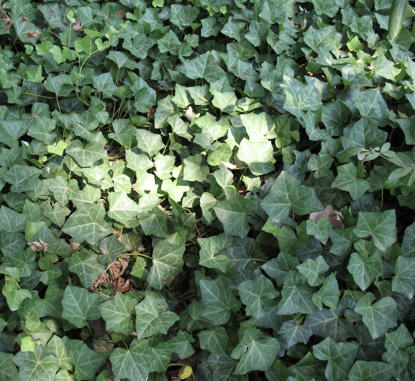P3335
English Ivy
Problems Caused
English ivy (Hedera helix L.) is a perennial trailing or climbing vine native to Europe. It has been cultivated since ancient times. It has been used as a ground and wall cover in landscapes, as a houseplant, and as greenery in floral arrangements. There are many cultivated forms of English ivy. The wild form has two leaf types: juvenile leaves, which are typically trailing, and adult leaves, which are typically flowering and hanging from trees. It can be problematic in all Midsouth states and is still sold in the nursery trade. Most cultivated forms are not invasive, but the typical wild form tends to be most prevalent where once planted, especially on old home sites. Although flowering can occur if plants are allowed to climb, juvenile forms are most common. English ivy can cause gastrointestinal poisoning in livestock.
Regulations
English ivy is not regulated in the Midsouth.
Description
Vegetative Growth
English ivy is a woody evergreen trailing (Figure 1) or climbing (Figure 2) vine. Vines may reach 90 feet when climbing, but on-the-ground plants are 6–8 inches tall. Trailing plants typically root at the nodes, although climbing plants attach by root-like holdfasts. Stems are hairless with simple, alternate leaves that may have star-like hairs on the petioles and lower leaf surfaces. Juvenile leaves are 1.5 to 4 inches long with three to five lobes (Figure 3). Leaves are dark green above, often with whitish veins, and lighter below. Adult leaves are entire, egg-shaped to triangular, and rounded to wedge-shaped at the base.



Flowering
Flowers are perfect and appear from June to October on adult vines. Flowers are hairy in globular terminal clusters that arise from a common point. Sepals are obscure; petals are thick, greenish-yellow, and 1/16 to 1/8 inch long. The fruit is a black, fleshy berry, ¼ inch across. Fruit contain two to five seeds that mature from April to May. Fruits may be poisonous. Seeds are just smaller than ¼ inch long and are apparently viable only when extracted from the fruit.
Dispersal
English ivy is primarily dispersed vegetatively by humans, either as an ornamental or through movement of soil.
Habitat
English ivy is a problem in fence rows, forests, disturbed areas, waste places, and open woodlands (Figure 1). It can form a dense groundcover, replacing the surrounding native vegetation. English ivy is hardy at least from Zones 4 to 9.
Distribution
English ivy is widespread in the United States but apparently not escaped in certain northern plains states. It has escaped in all southeastern states but is generally localized around old home sites. Once planted, it may persist for years, continually growing out from the original planting. It is still sold and may cause problems in landscapes. English ivy has escaped in all five Midsouth states.
Control Methods
Biological
None known.
Chemical
Known chemical controls for English ivy (Table 1) are limited. They include glyphosate (Roundup, Glyphos, Accord; 41 percent acid equivalent per gallon formulation) at 2 percent solution and triclopyr (Garlon, Remedy, Trycera, Triclopyr, Turflon; 4 lb acid equivalent per gallon formulation) at 2.5 percent solution. Control is generally slow, and symptoms may not be evident for some period following application. Add nonionic surfactant to triclopyr and any glyphosate product that the label requires.
|
Herbicide |
Formulation |
Method |
Rate |
|---|---|---|---|
|
Glyphosate |
Roundup, Accord, etc. 3 lb ae/gal |
Foliar |
2% solution |
|
Triclopyr |
Garlon, Trycera, etc. 4 lb ae/gal |
Foliar |
2.5% solution |
Mechanical
Small patches of English ivy may be removed by hand. Stems on the ground may root along the stem, making removal more difficult. Stems climbing trees can be cut near the ground and either left on the tree or removed from the tree. Mechanical control can be labor-intensive and slow.
Cultural
Cultural controls are not effective for English ivy because it grows in a wide range of environmental conditions.
More Information
Worldwide, there are from 4 to 11 species of English ivy, occurring from Europe to the Mediterranean region to East Asia. The genus Hedera is not native to the United States, although several plants are referred to as “ivy.” Dirr (1998) lists two additional species in cultivation: Hedera canariensis Willd. (Algerian ivy) and H. colchica Koch (Colchis ivy). Both tend to have larger leaves, and Algerian ivy has limited hardiness in the Midsouth.
References
Dirr, M. A. (1998). Manual of woody landscape plants: Their identification, ornamental characteristics, culture, propagation, and uses (5th ed.). Stipes Publishing LLC.
Knight, A. P., & Walter, R. G. (2001). A guide to plant poisoning of animals in North America. Teton New Media.
Miller, J. H. (2003). Nonnative invasive plants of southern forests: A field guide for identification and control. Southern Research Station.
U.S. Department of Agriculture, Natural Resources Conservation Service. (2007). The PLANTS Database.
The information given here is for educational purposes only. References to commercial products, trade names, or suppliers are made with the understanding that no endorsement is implied and that no discrimination against other products or suppliers is intended.
Publication 3335 (POD-04-25)
Revised by John D. Byrd Jr., PhD, Extension/Research Professor, Plant and Soil Sciences; Victor Maddox, PhD, Senior Research Associate, Plant and Soil Sciences; and Randy Westbrooks, PhD, former Invasive Species Specialist, U.S. Geological Sur.
The Mississippi State University Extension Service is working to ensure all web content is accessible to all users. If you need assistance accessing any of our content, please email the webteam or call 662-325-2262.
